Introduction

Usually when Thermalright has sent me an aftermarket cooler, whether it is for a CPU or a GPU, they tended to be built with the bigger is better theme to them. I haven't personally seen a lot of their earlier coolers, but with coolers like the Shaman, Silver Arrow and even the TRUE Black, there was never really a space saving thought in the whole designing and building process. Thermalright is seeing the market swing in custom built PCs, and currently that move is to either go to a gaming HTPC setup for your living room, or you just got tired of the huge cases and full ATX, and decide to save a ton of room at home and move into SFF builds. While there aren't a whole lot of options out there for Micro-ATX, the sensible move for most is to a Mini-ITX motherboard.
This is where Thermalright decides that maybe the bigger is better tactics that worked for so long, may not be the right idea to stay with in today's needs and wants in aftermarket cooling. The latest cooler to arrive takes in a few concerns of the very compact and not very space friendly cases associated with SFF builds or home theater cases. With home theater, there is usually a bit more room in most of the cases, but efficient cooling is always a concern and silence while doing so is a must. As for the SFF cases, and the use of a Mini-ITX motherboard, space is very limited, and depending on the socket location, things like the memory and video card are very close to the socket, leaving Thermalright with very little room for error if they plan to cool these boards as well.
This is why Thermalright has released the AXP-100, a low profile and very compact CPU cooler. This is a C-style cooler, just squished almost flat onto the base, but at first glance you realize right away that this is a Thermalright cooler. The ticker fins, the nickel plating, the finely polished base, and much like Noctua does, this Thermalright offers very unique colors for the frames and blades.
Even with the compact nature of the AXP-100, I plan to put this cooler through all the testing, and see if the AXP-100 can keep the heat at bay with the stock runs, but I also plan to see if this cooler will allow for any overclocking headroom. That in mind, let's jump into the specifications and pricing, so we can get a much closer look at the AXP-100, and see just how efficient this new low-profile CPU cooler really is.
Specifications, Availability and Pricing
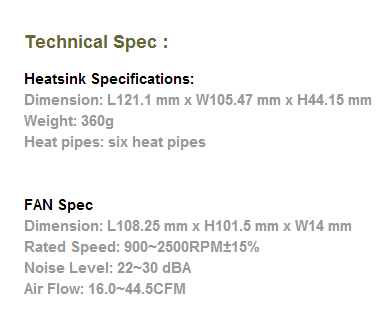
The chart is one of the most minimalistic attempts to show off product specifications I have ever seen, but let me try to embellish these a bit to give you the full feel for what you are buying.
The measurements are close, but my actual cooler is 123mm long (from pipe bends to pipe tips), the width is 105mm, and the height is just over 44mm without the fan attached. They cover the 360 gram weight and that there are six heat pipes, which just for reference are 6mm diameter pipes. This chart does not cover the 39 fins, the fact they are made of 0.4mm aluminum, or the fact that there is a support system to help keep the AXP-100 level. They also fail to mention that the base is made of copper, as are the heat pipes, and they even leave out that this cooler, once assembly is complete, gets a bath in the Nickel plating tank to give it that shiny and attractive look a lot of users tend to choose over exposed materials.
To be honest, there is more information given about the TY-100 fan accompanying the AXP-100 than there are specs for the body of the cooler. The included fan has a brownish-green frame with olive green blades, nine of them in total. This 100mm by 14mm fan is capable of speeds from 900 to 2600 RPM, and can deliver up to 44.5CFM with only 30dBA of noise. I was also sent a TY-140mm fan for testing since that is one of the options this cooler provides. The TY-140 is rated to speeds of 900 to 1300 RPM, delivering up to 74 CFM and only delivering 21dBA of noise to your ears. This fan is also a different color, where the frame is an olive green color, and the blades on it are blue. The reason for the 140mm fan mounting option is to not only reduce noise, but since the fan is much larger than the heatsink it cools, it has "excess" airflow to cool the motherboard or your memory.
As I look around, I still do not see this cooler on any shelves that Google is aware of. Even trolling the main haunts like Amazon, Newegg, FrozenCPU and many others, I was unable to locate it that way either. What I am aware of is that there is an MSRP of $59.95 established for the AXP-100 shipped with the TY-100 fan. Right up front, that seems a bit much for a low-profile cooler, at least most I am used to having a look at, but I do plan to try out both fans, various loads on the CPU, and see what sort of deal this is or isn't once I have all of the facts in front of me.
For now, let's have a look at what the AXP-100 offers aesthetically and functionally as we unbox it and get it mounted for testing.
Packaging
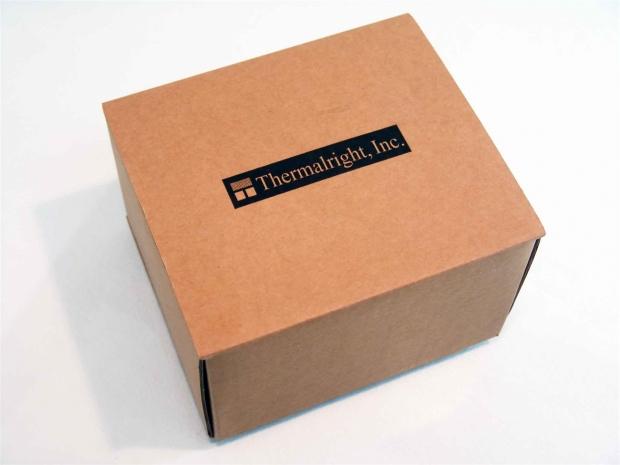
Just like most coolers to arrive from Thermalright, again they go with the plain brown cardboard box with black printing on it. Here on the top is one of three sides that hold any sort of information, and here it is just the Thermalright name and logo.
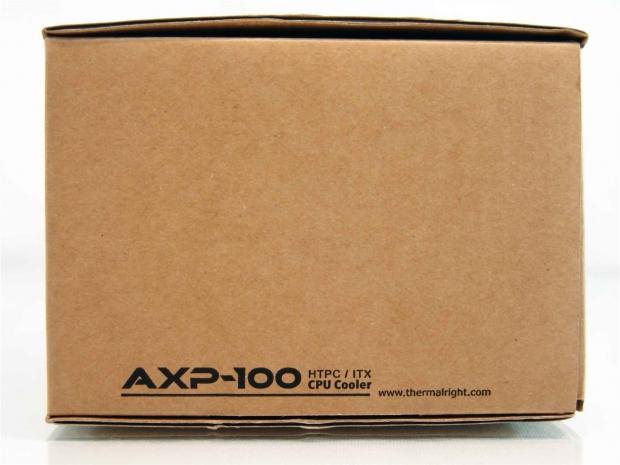
Both of the smaller sides look exactly like the left side shown here. Now you are given the name of the cooler, AXP-100, and a notation showing it is for HTPC and ITX use, and if you need it there is the web address.

When you first open the box, you are looking at a white cardboard box that is holding the hardware. I found it easier to flip the whole box over and shake out the hardware box, since there isn't a cutout to stick a finger in to remove it easily.
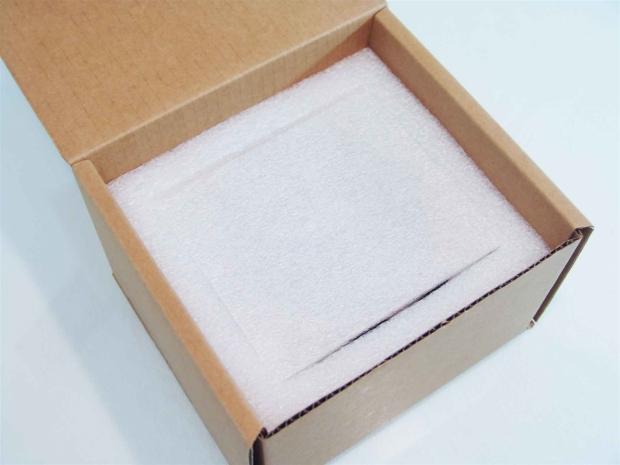
After setting the hardware to the side, then removing the manual and a sticker, you can finally see that the cooler is surrounded with some high density foam to make sure it is safe inside.
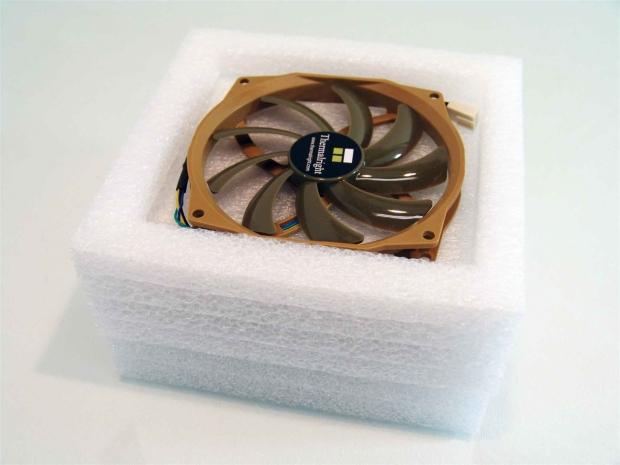
Under a thin layer of that foam you will find the TY-100 fan that cools the AXP-100. Lifting out the fan and another thin layer of foam you can find the cooler snugly fit into the bottom of the sandwich of foam.
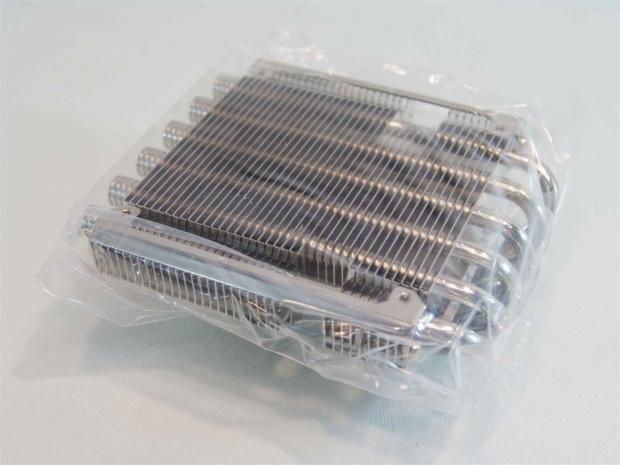
Taking things one step further, Thermalright even packages the cooler body in a plastic bag. While there isn't much inside to do any scratching on the cooler, this liner does allow the cooler to slide a bit on the foam, and with the plastic in place, it keeps the fins from grabbing the foam and potentially tweaking them out of alignment.
Thermalright AXP-100 CPU Cooler
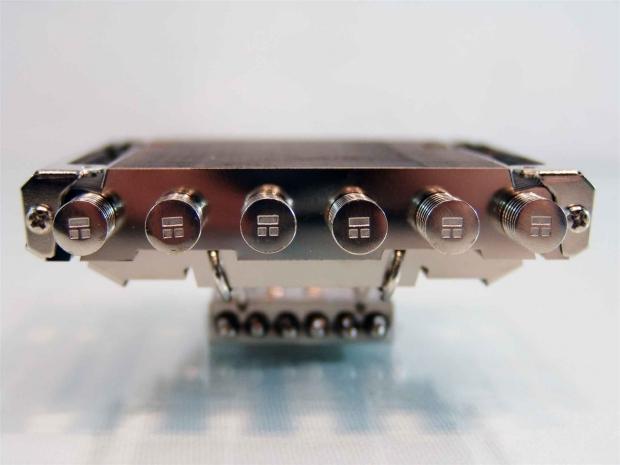
Starting with the side of the cooler, the heat pipes terminate as they exit it, and you can see that Thermalright adds caps to the six pipe ends, and each has the Thermalright logo on it. The screws on the outer edges are to hold on the fan mounting plates you will see in the next few images.
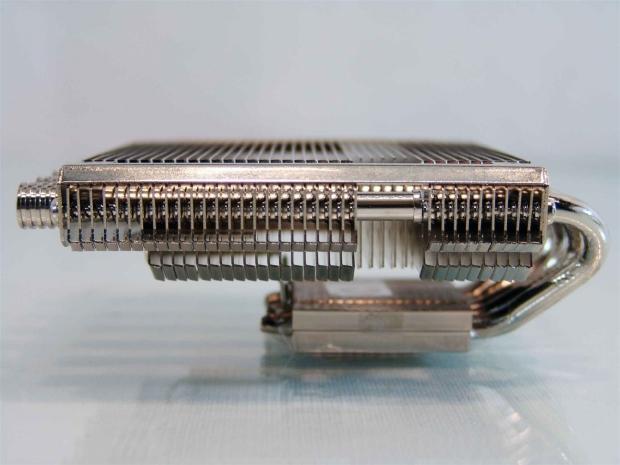
Each of the 39 fins of the cooler have tabs bent on the sides to keep the fins spaced properly. There is a section of five fins that are cut much shorter, exposing a heat pipe, but this is to allow access to the mounting hardware.
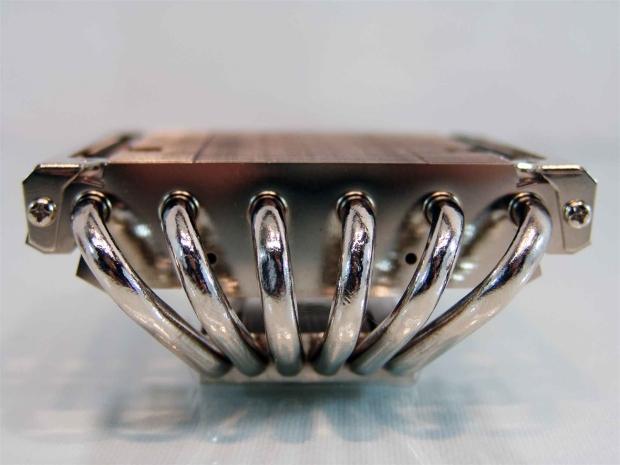
Since we are dealing with 44mm in total height, the six 6mm heat pipes are making some pretty tight bends to make it from the copper base, out and up, and then bending again as they return into the fins. Even so, Thermalright accomplished this with minimal distortion to the pipes.
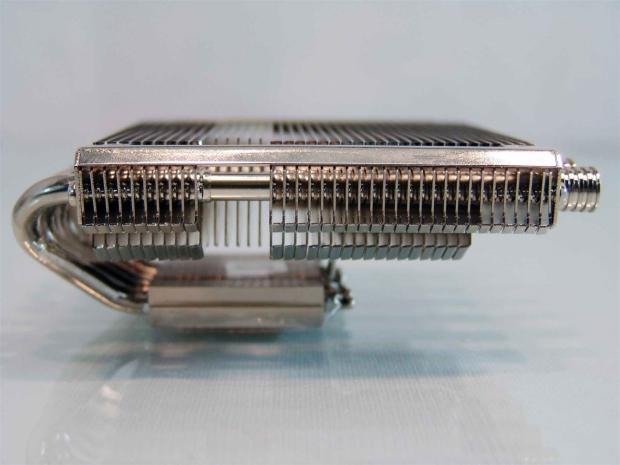
This is a direct match to the other side of the AXP-100, including the five shorter fins to allow you to get a screwdriver through the cooler body.
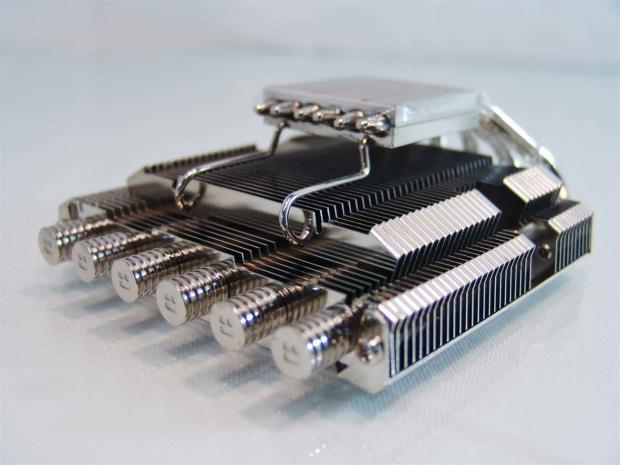
This image shows not only the two piece base that surrounds the pipes, but it also shows the thick wire support system that will keep users from deforming the pipes or changing the angle of this cooler on accident. Great little addition in my opinion, as I have had to re-bend other C-style coolers after using them a bit.
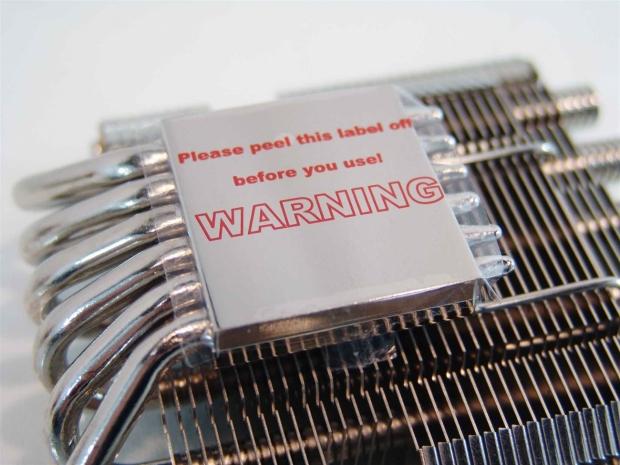
Since the entire cooler is nickel plated, you are given a protective sticker to keep the base in clean and unmolested condition. The sticker also has the warning on it to be sure to remove this prior to installation.
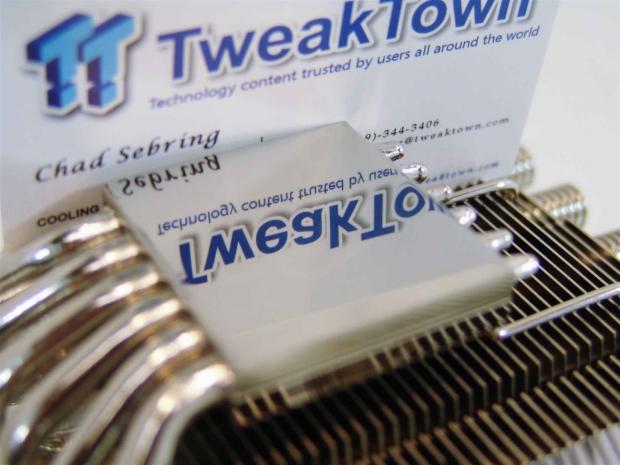
The only think I had close at hand was one of my business cards, so I grabbed it to show just how finely polished this base is. Near the edges, you will find slight deformation of the mating surface, but where the IHS makes contact on the base, it is very level and there was no light visible under the razor.
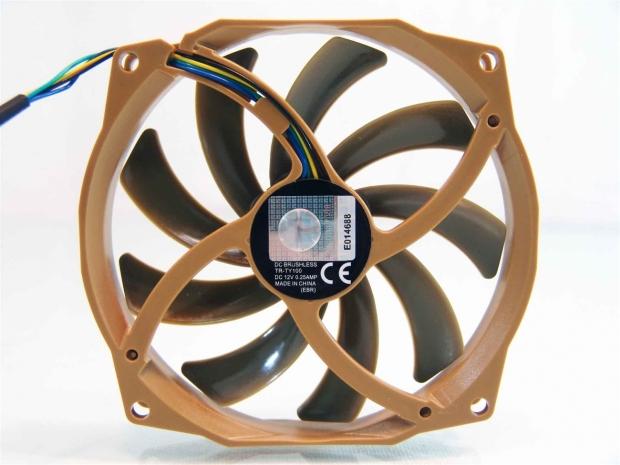
The 14mm thick, 100mm in diameter fan that is included in the box is what you are looking at here. The frame is a light brown, and the nine blades of the TY-100 are an olive green. With four wires leaving the fan motor, you can also assume there is a 4-pin PWM connection to feed this fan.
Accessories and Documentation
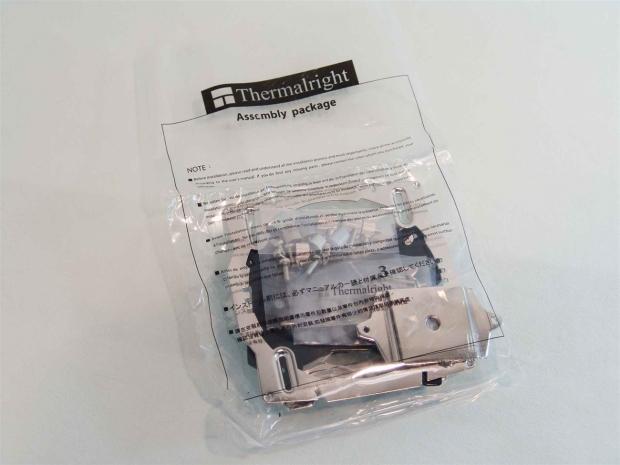
Inside of the white box that was sitting in the top of the box is where you find this sealed bag of hardware. This bag contains everything you will need to use the AXP-100, and since it is sealed, there is little likelihood of lost screws or washers.
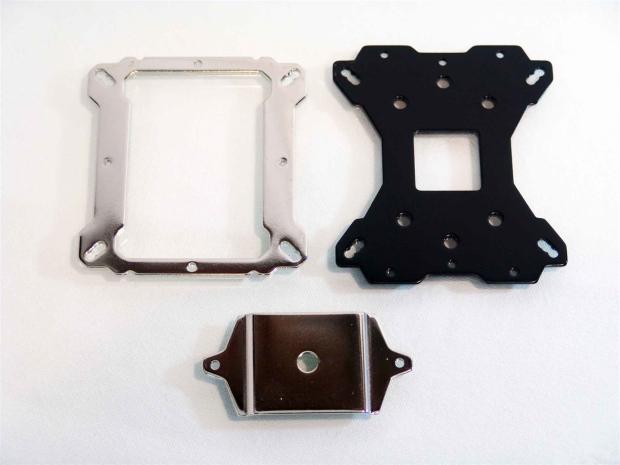
The larger bits of steel are to mount the hardware to the motherboard. At the top there is the top plate on the left and on the right is the back plate, both of which are universal for AMD and Intel sockets. At the bottom is what is used to secure the cooler to the rest of the hardware.
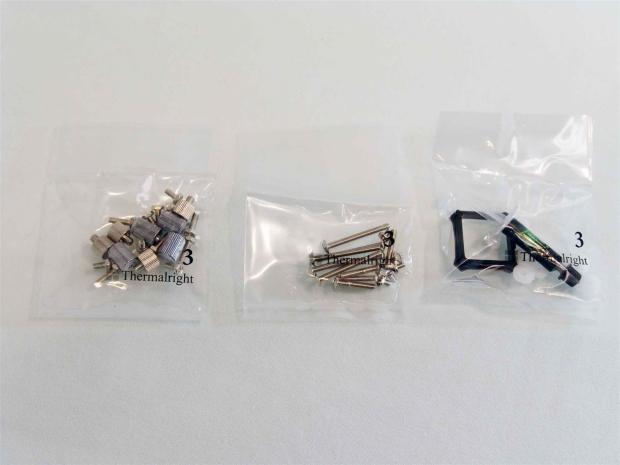
Even various bits of the hardware are individually sealed in bags. On the left are the screws and risers for AMD, Intel and even LGA2011 thumbscrews. The middle bag contains fan screws for the adapter plate, TY-140 mounting and TY-100 mounting. The bag on the right holds the LGA775 support, white spacers for the back plate, and a small tube of Chill Factor III thermal paste.
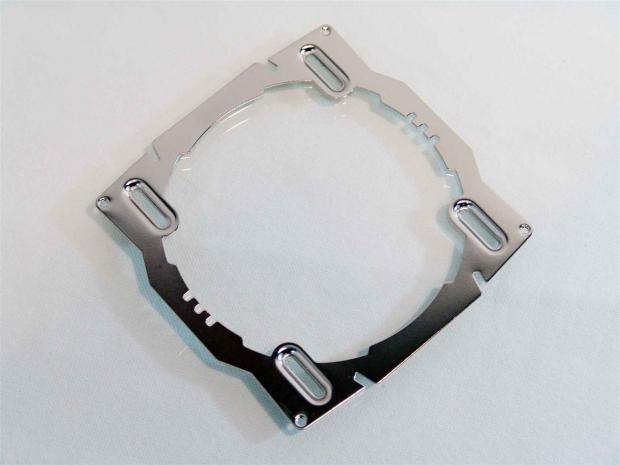
Thermalright also sends along the fan adapter plate. This allows you to use the 100mm fan mounting holes in the elongated slots, and then mount a 140mm fan on top of this. The reason for the slots is to allow the fan to move to a position where it is needed to keep motherboard components or you memory cool as well.
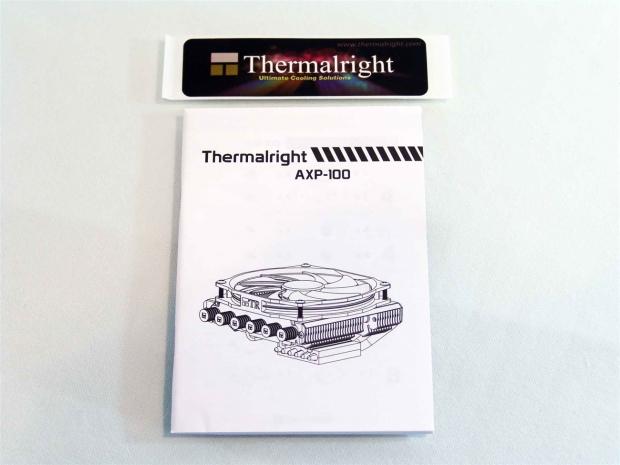
Here is the very easy to follow manual, and large Thermalright case sticker that has plenty of colors in it to match any system.
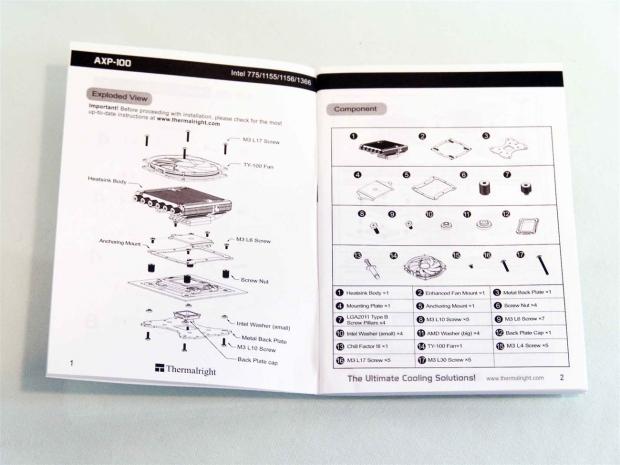
Basically, as far as the instructions go, this is it. On the left they take the cooler and in an exploded view, they show all the layering of parts that needs to go together to mount the AXP-100 to the motherboard. On the right is the key that will allow you to look at the image, then back to the chart to verify you have the parts needed to complete each layer.
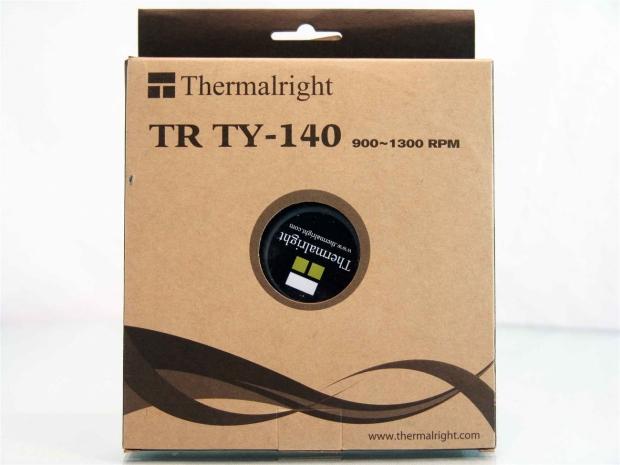
Thermalright also wanted me to take advantage of the fan adapter plate and sent along the TY-140 fan. This way I can show you if it is worth it to invest in the second fan as well.
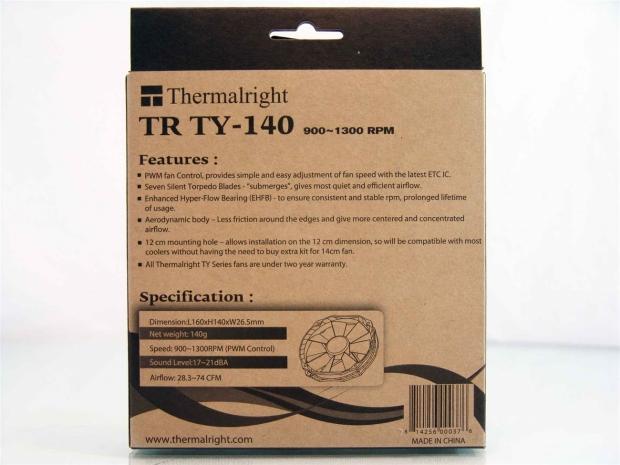
The back of the packaging covers the features of the PWM, the seven "Silent Torpedo Blades", the EHFB bearing, the frame design, 120mm mounting, and the two year warranty before it covers the technical specifications.
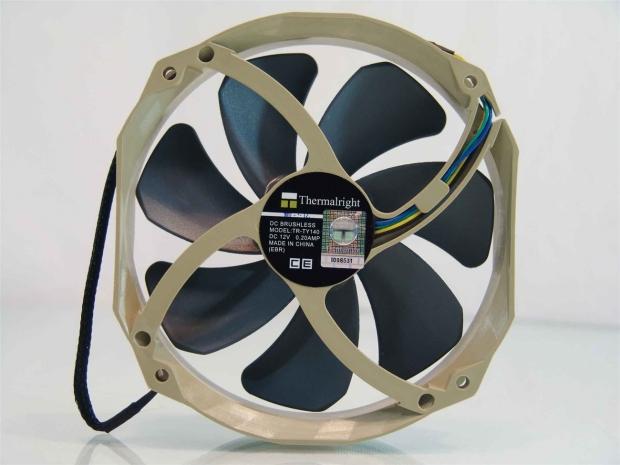
As I mentioned earlier, the color has changed along with the increase in fan size. Instead of the brown and green combo, this time the TY-140 comes in a green and blue combination of colors.
Installation and Finished Product
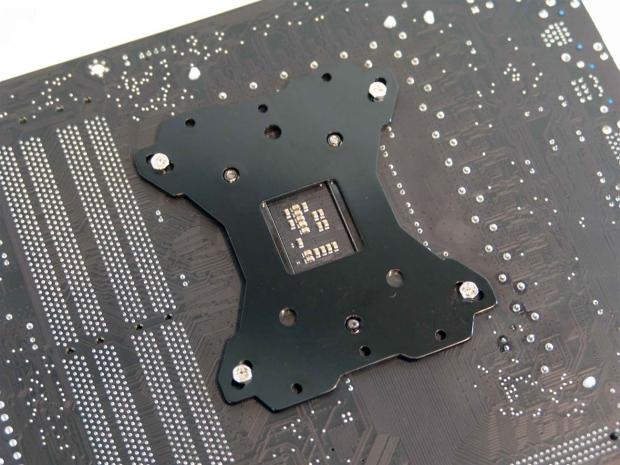
The back plate is designed to allow users to install it either side up, and it can be swapped end to end. The main thing to make sure of is to add the white plastic spacers to the screws to isolate this plate from the motherboard.
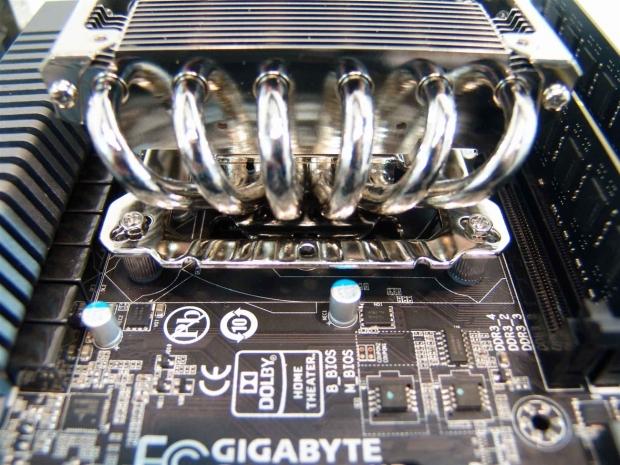
Since I forgot the top shot before I applied the TIM and set the cooler in it, I figured a shot taken at this angle would suffice. The screws through the back plate go into the riser that has a washer on it to set on the motherboard. Then you add the top plate and screw it in place.
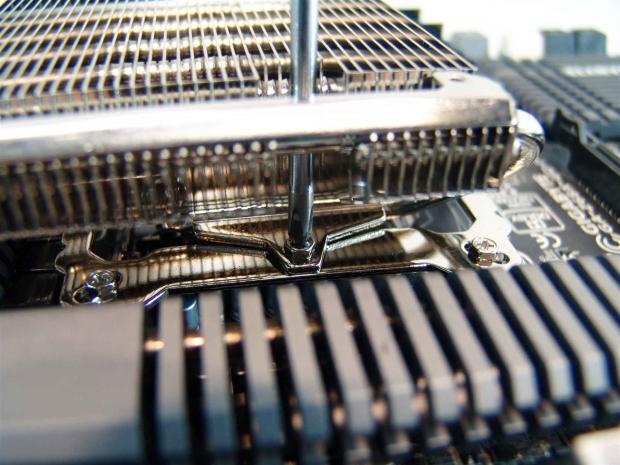
To mount the cooler to the top plate, this is where those gaps come into play. I would suggest a magnetic screwdriver, as you have to thread the needle with the driver and the screw to hit the plate under the cooler that locks it all securely to the motherboard.

Once the AXP-100 is securely mounted to the motherboard, you can then add the TY-100 from the box to the top with the screws that were provided. This will bring the overall height to 58mm, but it still is a very low-profile solution for a C-style cooler.
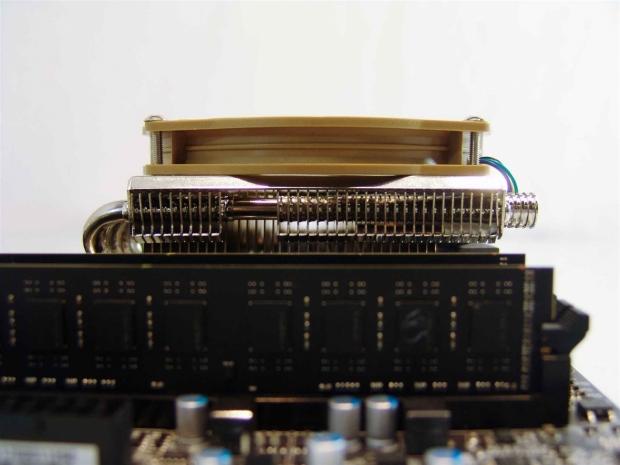
As you can see, the cooler is about twice as tall as my memory. If you have some of the taller heat spreaders on your memory, no worries there, you just block off the cooler from being viewed at this angle.
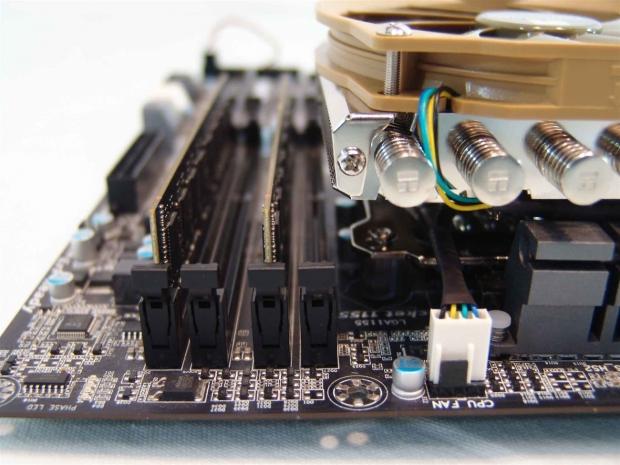
As you can see I have the pipe ends facing the top of the motherboard, and in this configuration the cooler stays clear of all four memory slots. If you turn it sideways, you are going to have the tips blocking taller memory, where if the bent pipes are here, it will fully block that slot.
Installation and Finished Product Continued
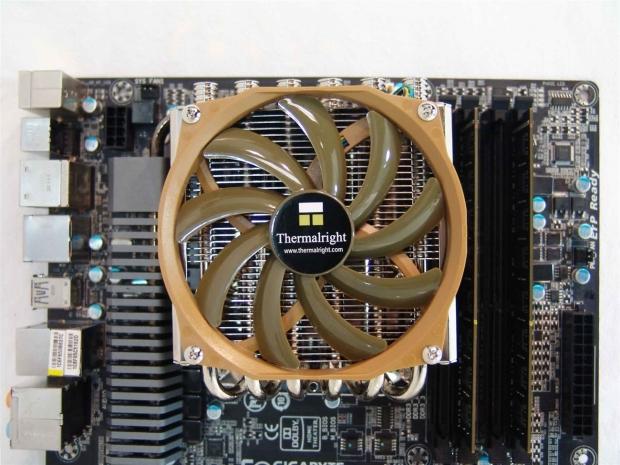
Taking a glance from above the AXP-100, you can see that the TY-100mm fan does a great job of covering the majority of the fins, and should have sufficient flow to keep this cooler under control with the heat from my 2600K under it.
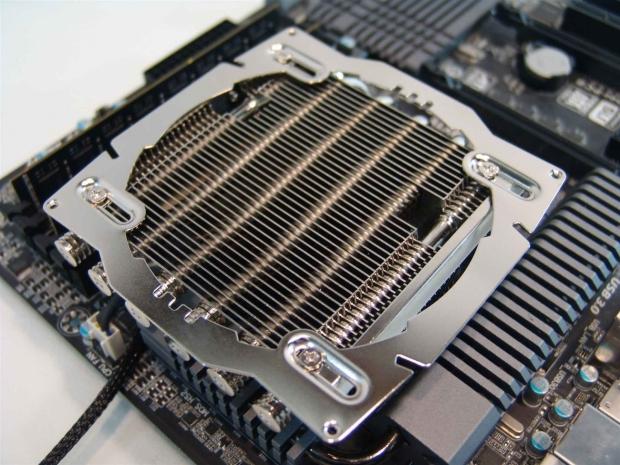
If you want there is the option to use this adapter plate. You can see the screws in the slots will allow the fan mounted on top to have about three-quarters of an inch of leeway to move back and forth. The wholes on the corners to mount the new fan to are 120mm spacing.
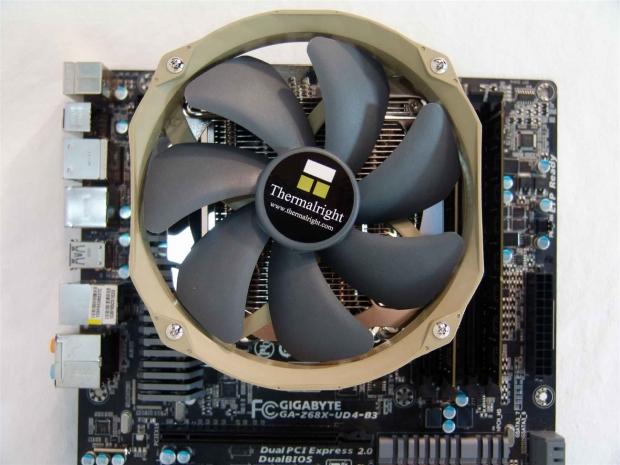
Again looking at the AXP-100 from the top, I slid the hardware to the left. This allows the 140mm fan to also cool the motherboard heat sinks, and in tiny cases, this is something that should be addressed to ensure longevity of the motherboard.
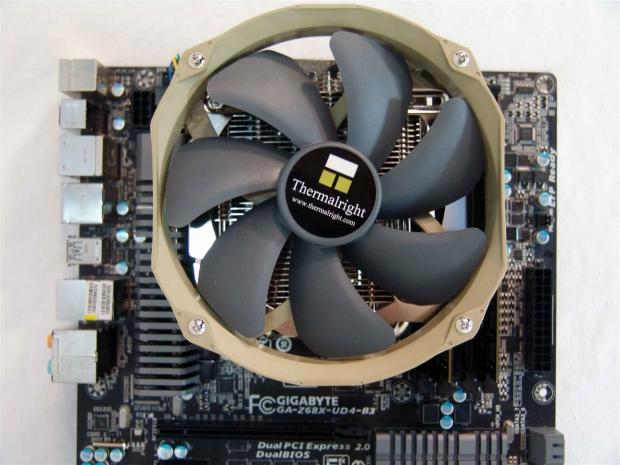
In this image the TY-140 is now slid all the way to the right. While it doesn't quite get all four channels, it does add a bit of air flow in between the sticks that otherwise it would not have with the TY-100 fan on this cooler.
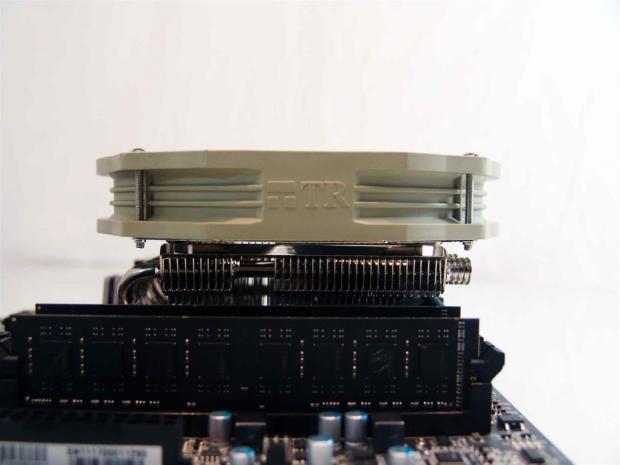
Even with this fan installed, you can see there is plenty of room for medium to large heat spreaders to fit under the fan. Since it doesn't completely clear the memory area when it is slid to the left, very tall heat spreaders may cause issues in that slot nearest the CPU.
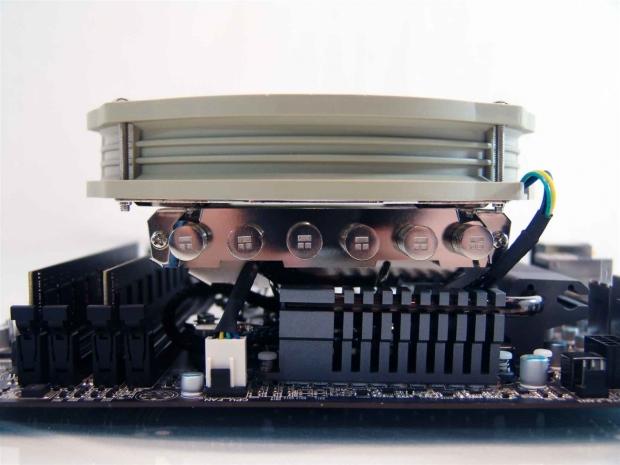
This is what I meant about it adds flow to either side of the CPU cooler. As it is set now, it can add flow to the memory, but not as much as a dedicated fan cooler. If it were reversed, it would add flow to the MOSFET heat sinks, just in case you want to overclock still.
The Test System and Thermal Results
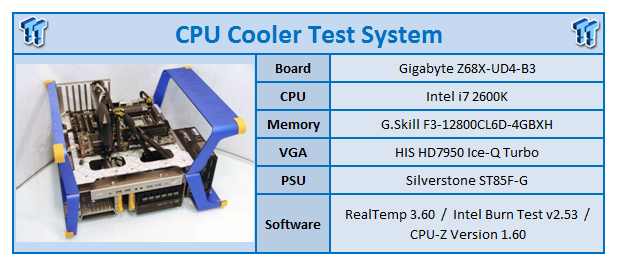
I would first like to thank HIS, GIGABYTE , InWin and AVADirect for supplying products for me to test with.
Testing for the CPU coolers is done with the use of RealTemp to ascertain temperatures, Intel Burn Test to deliver the load to the CPU and CPU-Z to verify the CPU speed and the voltage being used in Windows. All of the testing is done with an ambient temperature of 24.5-25�C and humidity is maintained to 35% sometimes less.
For the "stock" runs, it's more of a plug and play setup where the PWM of the motherboard is in control of the fans speeds for both the idle and load results. Speed Step is active and the processor idles at 1600 MHz and loads at 3500 MHz for the stock settings. I also set the memory to run at 1600 MHz for stock. As for the overclocked runs, I load the CPU at 4.5 GHz and idle results are obtained with 7.5V to the fans while the load run is set to deliver 12V to the fans. This allows me to gauge the lowest and highest fan ratings for my charts.
You will also see that the charts have been slightly adjusted. From now on I will mention the idle temperatures if there is something worth noting other than an average of twenty-five to twenty-seven degrees as the PWM controls and SpeedStep allow for almost ambient results in most instances. What you are now getting is a stock speed loaded temperature chart and an overclocked loaded temperature chart. To clean up the audio results, I also removed all of the fans that aren't on the thermal charts. If you want to compare those results to new coolers, the old chart is still available in the older reviews.
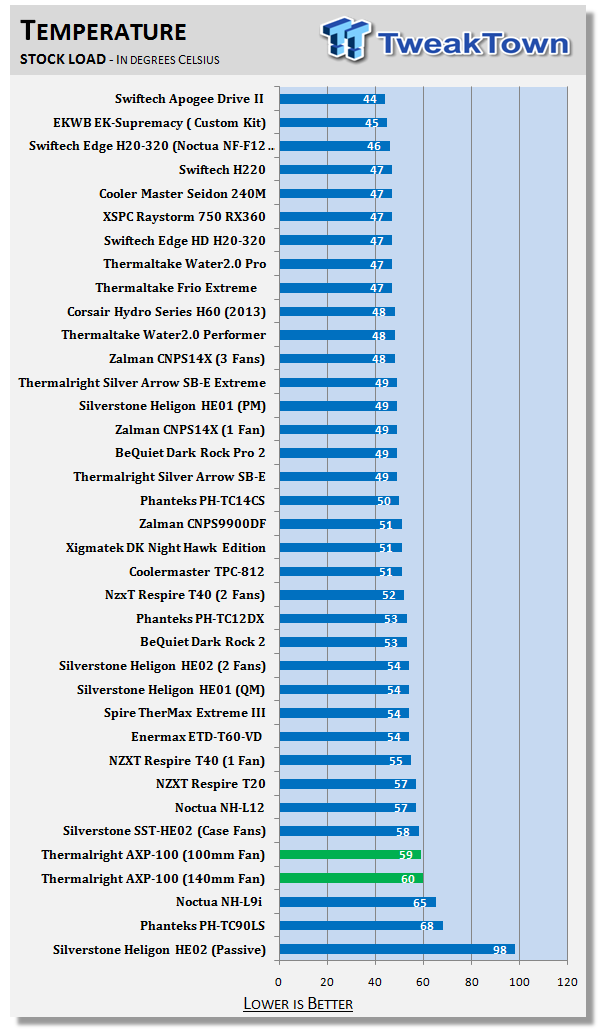
Considering the size of the AXP-100, and the fact that I have the cooler in the horizontal position when testing it, the results at stock are pretty good. The TY-100 mm fan is the better choice under PWM settings, due to the lower RPM of the TY-140 in these conditions. Coming in just behind the much large NH-L12, and in front of the NH-L9i and PH-TC90LS is right where it should be in my opinion.
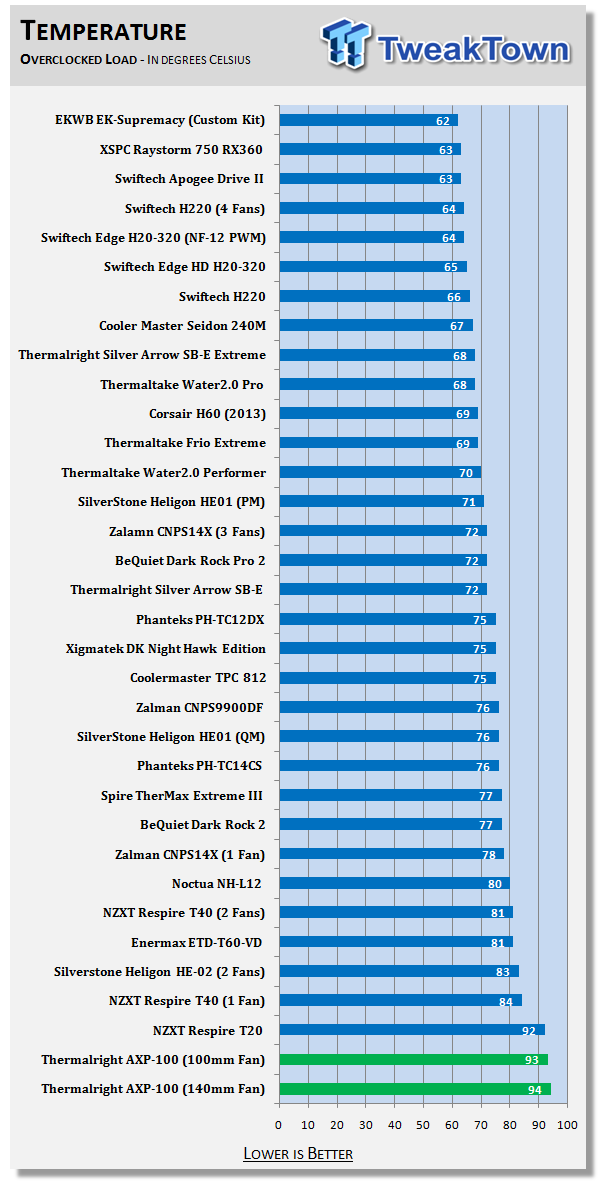
I went ahead and applied the overclock just for giggles to see how well I could abuse the AXP-100. Out of the three coolers I compared in the stock run, there is only one of those three that could even handle this without failing the testing due to overheating, but the AXP-100 was able to hang in there, and after some 45 minutes of abuse, I was reading 93 with the TY-100, and 94 with the TY-140.
I will say this though, while the TY-140 seems like a waste of time and energy, since the plate has 120mm fan mounting, you can easily swap out fans for something you have at home to allow whatever headroom you need, it just won't be near as silent as either of these solutions. All the same, I must give respect for the simple fact that this tiny little cooler was able to even finish this test.
Noise Level Results
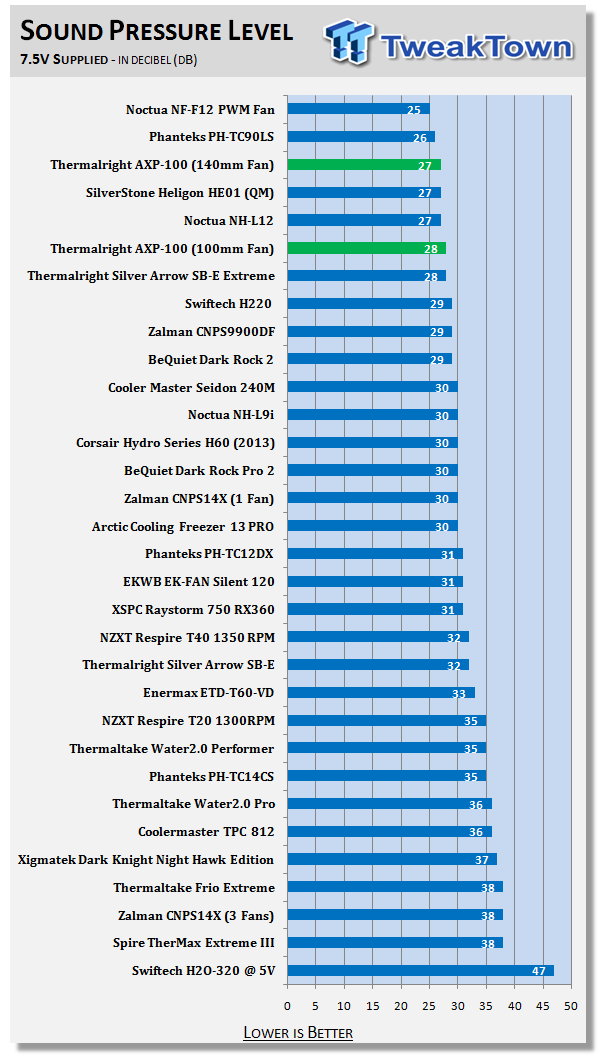
As I would expect, with the limited voltage supplied during the stock testing, the noise levels of both the TY-100 and the TY-140 were really good - some of the best results we've seen actually.
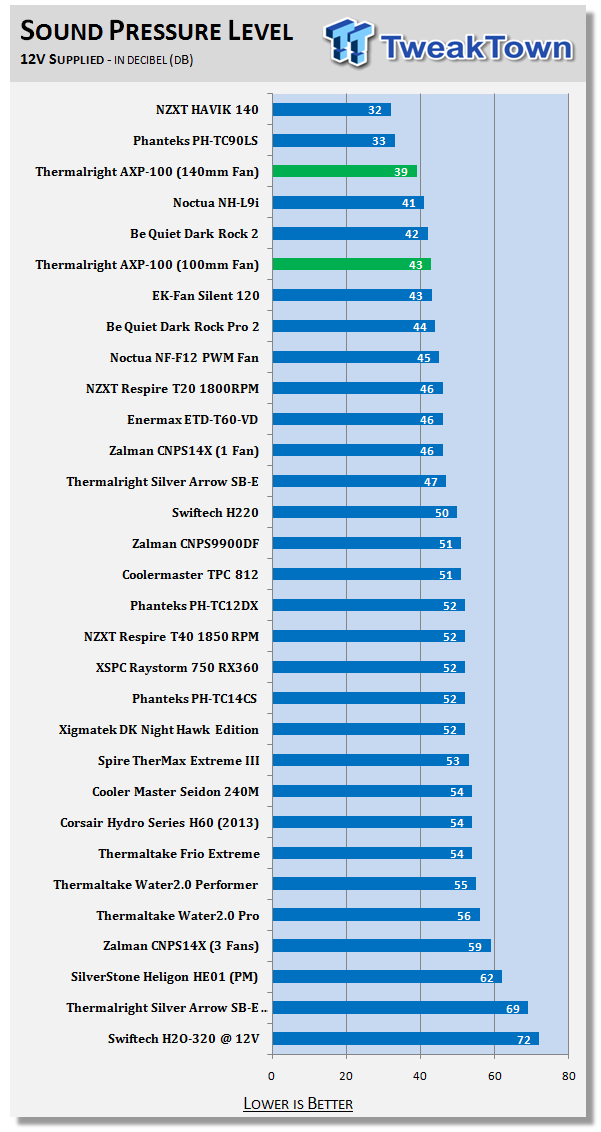
When I got to adding full power to these fans, I found that while the CFM increases, and you can tell the fan is spinning faster visually, the noise levels don't come up enough to be much of a bother at all.
Considering this is for HTPC environments, I can see why Thermalright chose these fans. For those in a SFF case, likely you are still gaming with a headset on and you can take a bit more fan noise, so the option for better efficiency than what I should is an easy fix for you.
Final Thoughts
To be honest, once I opened the box and saw the way the cooler was packaged, I thought to myself, this is nice, and more manufacturers should do this. Then as I dug the cooler out of the inner packaging and got to looking at it, I realized that this wasn't some fly-by-night design. There was a lot of thought and time that went into the AXP-100. First off it's a real pain to even get a C-style cooler this small, and still have it be effective enough to warrant any attention. Secondly, there is that trick little support system that keeps the cooler square and keeps users from kinking the heat pipes. Then, as if the fan on the cooler isn't perfect for what the AXP-100 is intended to do, they give users an adapter plate to allow them to throw on a Delta or Kaze fan if they wish.
From what I can see, and what I gathered from my testing, all that time and effort in the AXP-100 was well worth it. Here I am already saying I can see why its priced as it is, and I never covered the nickel coating, the pipe covers with TR logo's on them, nor did I cover the easy to use mounting system.
The fans I tested with are in fact plenty for the AXP-100, where the TY-100 actually performs better on the cooler than its larger brother. I was also advised that the fans being placed on the cooler to draw air off the motherboard would improve things since the fan wouldn't recycle heated air that way. I found that in my open air setup, it made no difference, but in a small form factor case with a PSU over it, it may make a couple of degrees difference. The reason the TY-140 did a little worse is for two reasons. When under PWM the fan speed was kept under 900 RPM most of the time, and hence not allowing the fan to really overtake the situation. At load, the CFM increases, but of course air seeks an easy path, and since the fan is larger than the fin body, you get a lot of the air ending up around the cooler, and not actually going through the cooler. By all means, if this isn't going in an HTPC, get a different fan and deal with the noise, the cooler has what it takes to keep even a heavy overclock under control; it just needs the right fan to help things along.
While my initial impression of the $59.95 MSRP was that it was a bit high, I have to say; at this point my mind is changed. The only coolers that may fit where the AXP-100 fits are the ETD-60-VD and the NH-L12, and both of those are larger and run closer to $70. On the other end you have the NH-L9i and the PH-TC90LS, which can be had at near $50 and $30 respectively, but neither of these coolers could finish the overclocked run of our testing. I have to say that Thermalright hit the low-profile market right where it had a hole, and I will bet that they will have no issues moving these coolers with the results I got with it.
It really is the perfect cooler for small environments. It allows you to use it in silence as-is and enjoy the comforts of managed thermals inside the PC and limited noise coming out of it. For those of you with something like the FT03 Mini, or even a Prodigy, slap in the AXP-100 and get a killer fan with high CFM and static pressure, and go ahead and clock the snot out of that gaming rig, the AXP-100 can handle the job with the right fan selection.



 United
States: Find other tech and computer products like this
over at
United
States: Find other tech and computer products like this
over at  United
Kingdom: Find other tech and computer products like this
over at
United
Kingdom: Find other tech and computer products like this
over at  Australia:
Find other tech and computer products like this over at
Australia:
Find other tech and computer products like this over at  Canada:
Find other tech and computer products like this over at
Canada:
Find other tech and computer products like this over at  Deutschland:
Finde andere Technik- und Computerprodukte wie dieses auf
Deutschland:
Finde andere Technik- und Computerprodukte wie dieses auf